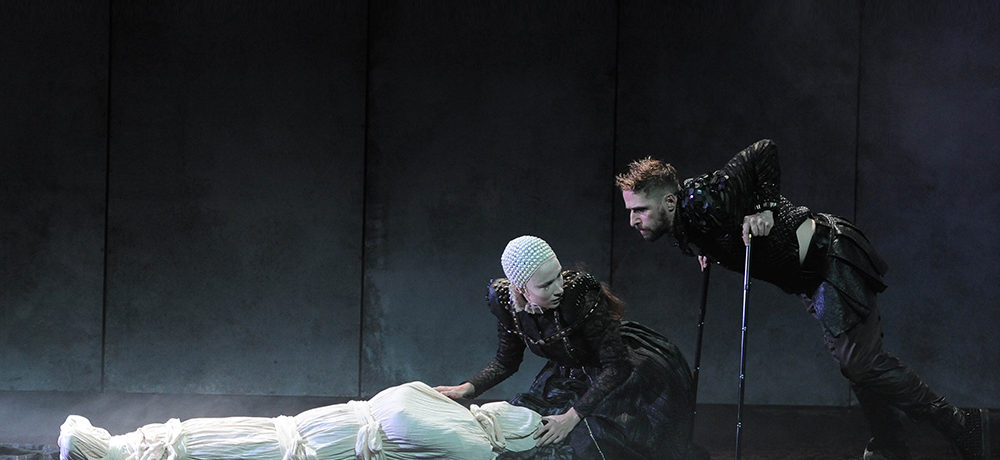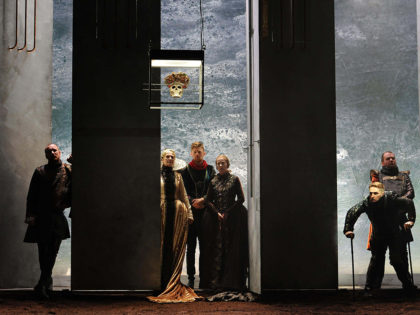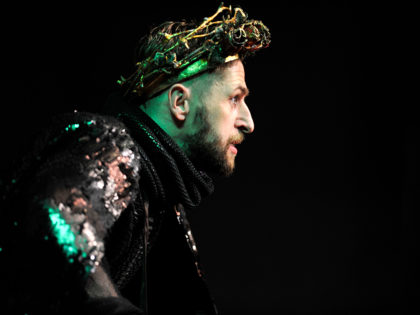Theater Reviews – 69.1
Dirty Work: DruidShakespeare’s Richard III at Lincoln Center’s White Light Festival

 In a glass box suspended above the stage, a skull grins out at the audience. Lit with cool, white light, it is the cleanest thing in sight. The stage itself is covered in dirt an inch or two thick. Below, stage left, a dingy, short-handled shovel leans against the wall. If the skull is a memento mori—an emblem of the vanity of human endeavors in the face of death—the shovel is its own kind of reminder: of the sheer physical labor that goes into those endeavors. Power, ambition, even villainy might in the end be mere vanity, but they’re also a lot of work. Somebody has to bury the bodies.
In a glass box suspended above the stage, a skull grins out at the audience. Lit with cool, white light, it is the cleanest thing in sight. The stage itself is covered in dirt an inch or two thick. Below, stage left, a dingy, short-handled shovel leans against the wall. If the skull is a memento mori—an emblem of the vanity of human endeavors in the face of death—the shovel is its own kind of reminder: of the sheer physical labor that goes into those endeavors. Power, ambition, even villainy might in the end be mere vanity, but they’re also a lot of work. Somebody has to bury the bodies.
At the start of DruidShakespeare’s Richard III, the Duke of Gloucester emerges from the dirt, popping abruptly out of a downstage center rectangular hole. That hole—besides the skull and the shovel, one of the only features of the production’s spare set—swallows up a number of corpses over the ensuing five acts. In this opening moment, though, it is not so much grave as womb. Born in grime and never far from it, Aaron Monaghan’s dynamic, scuttling, creeping, pouncing Richard is intimately acquainted with the dirty work his ambitions require, as well as the above-ground concerns of wooing recalcitrant widows, hoodwinking complacent courtiers, and whispering sinister hints to hired murderers and impoverished nobles. He is a clever machiavel: verbal, theatrical, and manipulative. But he is also, as Queen Margaret (Marie Mullen) calls him, a “rooting hog,” who revels in destruction and loves filth.
The play takes place in the aftermath of civil war: the defeat of Henry VI and, with him, the royal house of Lancaster, and Edward IV’s ascension to the throne. All England is, in a sense, a freshly dug grave. The bloody events dramatized in 3 Henry VI have ushered in a pause, a fragile moment of peace. In his opening soliloquy, which starts as a reflection on that peace, Richard, Duke of Gloucester, laments his boredom. Now that “grim-visaged war” is over, there’s nothing for the King’s brother to do—except, perhaps, make love. But how can he, “deformed, unfinished, sent before my time/ Into this breathing world, scarce half made up,” hope to be a lover? He has little choice, therefore, but to set about usurping the throne. Monaghan’s Richard is tickled with the absurdity of his own logic here, with the false set of choices his speech creates, and he lets the audience in on the joke. No one in the theater could possibly be convinced that Richard decides to “prove a villain” simply because he cannot “prove a lover”—least of all Richard himself—but that doesn’t matter. If it is easy to see the flaws in his thinking, it is hard to resist the abundant pleasure he takes in his own logical leaps and in the rhetorical sleight of hand that, at best, half-disguises them. He spins discontent into self-delight. As he soliloquizes, his voice travels up and down the scale, now rising to a breathless falsetto of feigned grievance, now falling to a gravelly threat.
 Monaghan’s nimble locutions are the center of this production. In a sharp but subtle way, his performance is a revelation: Richard lies, but he isn’t a particularly convincing liar; Richard distorts the truth, but the truth remains perfectly available. Yet this doesn’t matter. Unlike, say, Iago, this rhetorically virtuosic villain has no real interest in changing people’s minds. He wants power, and he doesn’t expect his most outrageous lies to be believed so much as to bludgeon their hearers into submission: as his words pour forth, he renders his interlocutors variously baffled, exhausted, outraged, and helplessly inarticulate. Take, for instance, the early scene in which he bursts upon Queen Elizabeth (Jane Brennan) and various nobles at court, complaining that he has lost the King’s favor “because I cannot flatter and look fair.” The Queen observes that he has in fact have lost favor because his “outward action” consistently reveals an “interior hatred” against her and her children. Richard then accuses her of sowing discord between his brothers, King Edward (Bosco Hogan) and Clarence (Marty Rea)—who has been imprisoned in the Tower because of rumors Richard spread, and who will, in the next scene, be murdered at Richard’s bequest. Elizabeth responds that she has done nothing but plead Clarence’s case to her husband. There is no reason for anyone in the scene to believe Richard over Elizabeth; indeed, there is plenty of reason for the gathered nobles to disbelieve him. Yet his extraordinary bluster overwhelms her truths. It is louder, crazier, slipperier; it is impossible to argue with. Some are taken in: Hastings (Garrett Lombard) later earnestly remarks of Richard, “by his face straight shall you know his heart.” (Moments later Richard bursts onto the scene, accuses Hastings of witchcraft, and has him hauled off to execution.) Most others, however, are not. In this version of Shakespeare’s history, fooling people matters less than silencing them.
Monaghan’s nimble locutions are the center of this production. In a sharp but subtle way, his performance is a revelation: Richard lies, but he isn’t a particularly convincing liar; Richard distorts the truth, but the truth remains perfectly available. Yet this doesn’t matter. Unlike, say, Iago, this rhetorically virtuosic villain has no real interest in changing people’s minds. He wants power, and he doesn’t expect his most outrageous lies to be believed so much as to bludgeon their hearers into submission: as his words pour forth, he renders his interlocutors variously baffled, exhausted, outraged, and helplessly inarticulate. Take, for instance, the early scene in which he bursts upon Queen Elizabeth (Jane Brennan) and various nobles at court, complaining that he has lost the King’s favor “because I cannot flatter and look fair.” The Queen observes that he has in fact have lost favor because his “outward action” consistently reveals an “interior hatred” against her and her children. Richard then accuses her of sowing discord between his brothers, King Edward (Bosco Hogan) and Clarence (Marty Rea)—who has been imprisoned in the Tower because of rumors Richard spread, and who will, in the next scene, be murdered at Richard’s bequest. Elizabeth responds that she has done nothing but plead Clarence’s case to her husband. There is no reason for anyone in the scene to believe Richard over Elizabeth; indeed, there is plenty of reason for the gathered nobles to disbelieve him. Yet his extraordinary bluster overwhelms her truths. It is louder, crazier, slipperier; it is impossible to argue with. Some are taken in: Hastings (Garrett Lombard) later earnestly remarks of Richard, “by his face straight shall you know his heart.” (Moments later Richard bursts onto the scene, accuses Hastings of witchcraft, and has him hauled off to execution.) Most others, however, are not. In this version of Shakespeare’s history, fooling people matters less than silencing them.
The play’s two wooing scenes emphasize the point. The first comes on the heels of Richard’s opening soliloquy, as the Duke of Gloucester encounters Lady Anne (Siobhan Cullen) bearing the corpse of her father-in-law, Henry VI. The scene is staged in an extraordinary way. (Gary Hynes, as director, creates striking stage pictures throughout, brilliantly juxtaposing movement and stillness.) Instead of being carried on a bier by attendants, Henry’s corpse, swathed entirely in white fabric, lies atop the massively black velvet train of Anne’s dress. Alone and bent double to pull her grisly load, Anne moves across the stage, lamenting his death and that of his son, her husband, both at Richard’s hands. When the Duke appears and, famously, confronts her hatred with protestations of love, the corpse becomes a still point. Surrounded by a huge fan of black fabric, it anchors her in grief and loss, but also pins her in place, at Richard’s mercy. As she stands still, he scuttles around her like a flightless bat, flopping to the ground and baring his chest, inviting her to stab him, and claiming that “’twas I” that killed Henry and Edward, not for political gain, but because “thy beauty… provoked me.” Watching the scene, it does not feel like Cullen’s Anne is taken in, let alone seduced. She seems instead profoundly bewildered, at a loss for the right words, or even the right feelings, in the face of his torrent of absurd claims. Later, Richard employs the same tactic on Queen Elizabeth: I killed your sons, he asserts, out of love for your daughter. Richard has by this point gained the throne, and to do so he has arranged the deaths of his brother Clarence, the lords Rivers (Peter Daly) and Hastings, and the two young princes (Siobhan Cullen and Emma Dargan-Reid). Faced with both the king’s power and his brutality, Elizabeth has no real choice but to acquiesce. In a performance that mingles calculation with loathing, Brennan’s Elizabeth does so—making it clear, however, that she is in no way persuaded.
 If the production is topical at all, it is in this: it reminds us that falsehood does not need to elicit universal belief—or belief, period—to be a tool of power. For the most part, though, the show doesn’t reach towards contemporary political allegory, instead producing a crisp, intelligent interpretation of the text unhooked from topical particulars. The design of the show creates a world at once timeless—most of Frances O’Connor and Doreen McKenna’s costumes are Elizabethan-inspired, but with touches that would not be out of place on a contemporary runway—and marvelously, weirdly specific: women wear gigantic bustles; as King, Richard dons a cloak covered in what look like metallic feathers; the two princes wear soft velvet caps, underscoring their vulnerability. Though the dominant color is black, almost every costume contains elements that reflects light, from Anne’s gleaming cap of pearls, to Elizabeth’s dress of mingled black and glimmering gold, to Richard’s own black sleeves, which glint as though covered in thousands of tiny onyxes. The entire atmosphere is of dark glitter: bleakly gorgeous, sinister and sumptuous at the same time.
If the production is topical at all, it is in this: it reminds us that falsehood does not need to elicit universal belief—or belief, period—to be a tool of power. For the most part, though, the show doesn’t reach towards contemporary political allegory, instead producing a crisp, intelligent interpretation of the text unhooked from topical particulars. The design of the show creates a world at once timeless—most of Frances O’Connor and Doreen McKenna’s costumes are Elizabethan-inspired, but with touches that would not be out of place on a contemporary runway—and marvelously, weirdly specific: women wear gigantic bustles; as King, Richard dons a cloak covered in what look like metallic feathers; the two princes wear soft velvet caps, underscoring their vulnerability. Though the dominant color is black, almost every costume contains elements that reflects light, from Anne’s gleaming cap of pearls, to Elizabeth’s dress of mingled black and glimmering gold, to Richard’s own black sleeves, which glint as though covered in thousands of tiny onyxes. The entire atmosphere is of dark glitter: bleakly gorgeous, sinister and sumptuous at the same time.
Two characters stand apart, visually, from the rest: Queen Margaret, the widow of the dead King Henry, and Catesby (Marty Rea), Richard’s councilor and, in this production, his trusted executioner (Catesby, here, absorbs various other roles from Shakespeare’s text). Dressed in pale rags, her feet and legs bare and her white hair disheveled, Margaret haunts the court like a kind of disintegrating ghost. Early in the play, she crouches in the dirt, before rising to curse the Queen for possessing what she has lost: a royal seat, and living children. She curses the lords Rivers and Hastings for standing by as her son was “stabbed with bloody daggers.” She warns Buckingham (Rory Nolan) that Richard will “split thy very heart with sorrow.” As the action unfolds, her curses come true—and, here, Catesby brings them into being. Like Margaret, he is dressed differently from the rest. A plain white shirt, black bowler hat, and black waistcoat mark him as non-aristocratic; he is Richard’s lackey, part-bureaucrat, part-laborer. And, like Margaret, he belongs, in a way, to the dirt: whereas she stands in it, the bottoms of her feet dark with grime, he sends people into it, killing off first Rivers, then Hastings, then Buckingham in a series of chillingly methodical execution scenes that punctuate Richard’s ascent to the throne. In each scene, the victim sits on a chair, facing forward, just upstage of the central rectangular hole. Each victim in turn recalls Margaret’s curse, as Catesby unspools an enormously long power cord, attached to what looks like a bolt pistol. His voice neutral and his face a blank, he holds the pistol to the victim’s temple and pulls the trigger with an enormous bang. The body drops from the chair into the hole, and Catesby puts his tools away. Royal politics glitters and shines; it is full of misdirection, bluster, theatricality, surprise. But the dirty work underneath it is shockingly straightforward, and starkly matter-of-fact.
